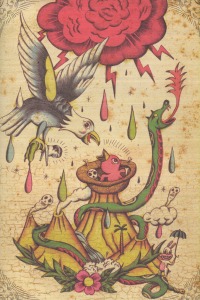| ________________
CM . . . . Volume XVII Number 41 . . . . June 24, 2011
excerpt:
My Tattooed Dad is a colourful kaleidoscope of tall tales told by a father to his young son. The father is often away from home for unexplained reasons, but he is omnipresent in his son's life and imagination. Each time the tattooed dad is home, he reveals the story behind one of the numerous tattoos that cover his entire body: "Reading his tattoos is more fun than reading any book ever written. Tigers, elephants, gorillas, winding serpents, magical birds, spiders...faces, firecrackers, crazy machines...they cover his whole body" (p. 3). The son uses these stories that his father leaves behind to build an imagined father in the flesh and blood absence of the real one. A sailor, a hero, an adventurer, a charmer – his father is all of these things in his stories, wrestling with two-tailed tigers, catching speeding bullets with his bare hands, and catching his plummeting infant son through a car window. Rife with violence, superstition and monsters, the stories are not meant to be taken literally; like fables, each holds an ideal for the son to emulate. The father concludes one of his letters with, "Congratulations, son. You are almost a man" (p. 18), underlining his presence/absence in their relationship. The book is admirable for depicting an untraditional family dynamic: a young boy's relationship with his absentee father is viewed through neither a pitying nor a saccharine lens, and although the boy's mother is present, the driving force of the book is the father-son interaction.
Magicomora's excellent illustrations help somewhat to unify the fragmented narrative. The aesthetic appeal of the book is undeniable: the Spanish artist's pop art, surrealist style is colourful and memorable, working classic tattoo motifs into every page. Receiving acclaim from the Association of Illustrators of Catalonia as "best children's book," Magicomora breathes life into this book by introducing a style of art that is not traditionally associated with children's picture book illustration. The pictures are hand-drawn with pencil and paper before colour is added digitally in order to achieve bright, vibrant images. Nesquens' poetic descriptions, such as "[w]e flew through a mint-flavored cloud, swooping in circles" (p. 21), are paired with Magicomora's lively vignette full of a jewel-toned serpent breathing fire, a monstrous albatross, lightning bolts, skull-shaped smoke clouds. The combination of the text and the visual is jarring, but it serves to highlight the surreal nature of the story. More than mere accompaniment, the pictures in this book work as stand-alones and wonderful playgrounds for the imagination, enhancing the vibrancy of the tales. But for all its fantastical illusions, the story ends on a bittersweet note, with the son trying to find substance in his father's fables. He wrestles to fit the fragments that he has been given into a cohesive narrative, to create a solid version of the father who he only knows through tall tales. The son decides, finally, that his father is understood as a paradox, a tangled web of stories:
My Tattooed Dad will find greater resonance in a sophisticated reader who is able to understand the mixture of sadness and sweetness in this family. The illustrations, as well as some of the fast-paced scenes, will certainly appeal to boys who are looking for alternatives to coddling, pastel-toned books. Although it is not an easy read with its fragmented structure and unusual phrasing, My Tattooed Dad curiously lingers in the mind long after the last spectacular page. Recommended. Sabrina Wong is a MLIS candidate at the University of British Columbia.
To comment
on this title or this review, send mail to cm@umanitoba.ca.
Copyright © the Manitoba Library Association. Reproduction for personal
use is permitted only if this copyright notice is maintained. Any
other reproduction is prohibited without permission.
NEXT REVIEW |
TABLE OF CONTENTS FOR THIS ISSUE
- June 24, 2011.
AUTHORS |
TITLES |
MEDIA REVIEWS |
PROFILES |
BACK ISSUES |
SEARCH |
CMARCHIVE |
HOME |

 Each chapter begins in the banal world of the son before leaping headlong into the fabulous world of the father's tales. Since the use of the first person shifts back and forth between the father and son, typography is used as a visual cue to make clear who is speaking. This stylistic choice makes the story slightly easier to follow, but a cohesive, unifying narrative is missing. The phrasing is also somewhat lost in the translation from Spanish to English by Elisa Amado, and readers may find that the sentences require a second reading to decipher. Overall, the fables have promise, but at times, it is difficult to figure out how the pieces fit in the big picture.
Each chapter begins in the banal world of the son before leaping headlong into the fabulous world of the father's tales. Since the use of the first person shifts back and forth between the father and son, typography is used as a visual cue to make clear who is speaking. This stylistic choice makes the story slightly easier to follow, but a cohesive, unifying narrative is missing. The phrasing is also somewhat lost in the translation from Spanish to English by Elisa Amado, and readers may find that the sentences require a second reading to decipher. Overall, the fables have promise, but at times, it is difficult to figure out how the pieces fit in the big picture.